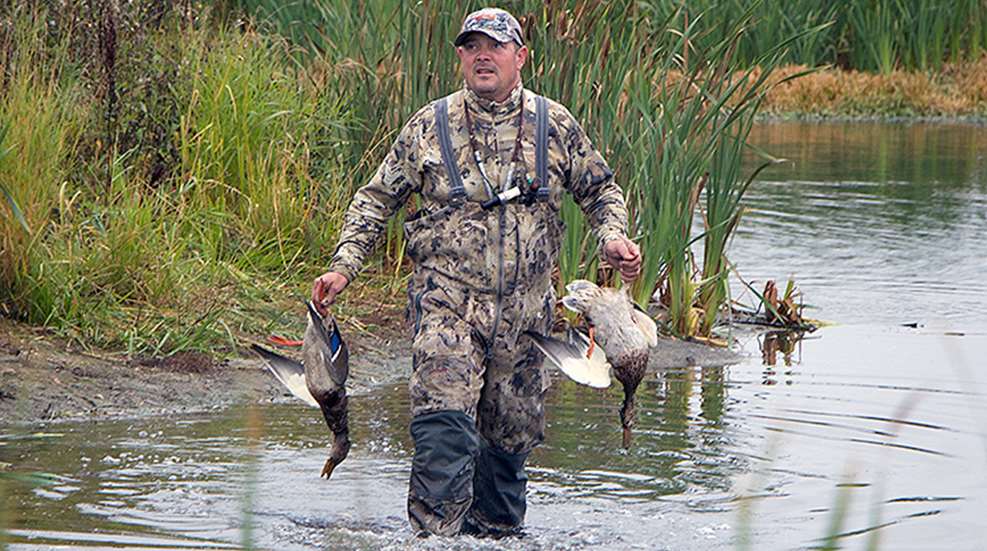
In waterfowl hunting, there are traditional tactics—like arranging a decoy spread and luring birds with calling—and then there are some, shall we say, rather zany tricks. A few, such as “baiting” the blind with plastic corncobs, simply cause me to chuckle. However, occasionally I hear of an outlandish ploy so crazy that, well, it just might work. Here are a few that I haven’t personally tried but that may be worth a shot.
The “Plond” Artificial Wetland
Do you have a property that gets good duck traffic overhead but that lacks a proper wetland to draw them in? No problem, just build yourself a “plond”—short for plastic pond. If there are ducks in the area, particularly if they’re fresh migrators, you might just convince them there’s an inviting spot below.
Plond aficionados say a large black tarp creates the most realistic setting. Once you’ve selected a location, dig a shallow hole to position the tarp so that the surrounding grasses hug it in a realistic manner. After all, real ponds don’t sit atop the field. Then all that’s left is addition of a few decoys.
I doubt it’s possible to actually “finish” ducks on a plond, but you may get some close enough to call the shot. Those who employ the tactic swear it works and have the photos to prove it.
Hide Behind a Cow
For reasons I don’t fully understand, dairy farms tend to be excellent places to find ducks. Trouble is, often the mallards are concentrated on creeks and streams flowing through open pastures. Perhaps that’s why the ducks feel safe: There’s nowhere for hunters to hide or to stealthily approach for a jump-shoot.
Except, perhaps, from behind a cow. No, I don’t suggest walking up to a Holstein and shuffling along with her. They tend to be gunshy. But I know of hunters who’ve built rather elaborate cow silhouettes to use as makeshift blinds. The hunters are completely exposed from above, but if you find a mallard honeyhole in the middle of cow pasture, hey, it’s worth a try.
All Motion-Decoy Spread
If one motion decoy is good and sometimes two are even better, wouldn’t a couple dozen be best? Or so figure those rare waterfowlers using a spread consisting exclusively of motion decoys.
Sounds crazy—if not expensive—but there’s one scenario when I think it may prove quite effective: Just ahead a heavy cold front, when migration peaks and carbohydrate-starved mallards are heavily dry-feeding. When hungry ducks hit an agriculture field, there’s an absolute flurry of activity as they compete for food, hopping over one another and shoving their compatriots. If you target such ducks, there’s almost no such thing as using too much motion to draw them in.
So, while the all-robo spread may seem bizarre, in the described case it’s also rather natural. I’d tweak it just a tad by adding some full-body ducks and/or geese to finish the birds.
Three Lonely Decoys
You don’t necessarily need a massive spread to kill mallards, but I generally prefer at least 2-3 dozen decoys. It’s pretty difficult to get birds to commit to a spread they can’t see. However, I have a friend who insists three decoys work better in the early season, when tiny trios of local mallards are common on area creeks.
“I mostly like it for simplicity’s sake,” he said under condition of anonymity. “But also I find it easier to work pairs and small groups of resident ducks. And on a small stream it allows extra space for a landing zone.”
Is he crazy? Perhaps, but last week he shot a pair of mallards that pitched to a mere two decoys. Who knows … if your decoys look sufficiently lonely, maybe you’ll find some sympathetic mallards to provide them company.
Mirror Image
Here’s one for you jump-shooters: Next time you attempt to put the sneak on a pile of birds, hold a giant mirror in front of yourself. I know of an individual in southern Pennsylvania who uses the tactic to approach giant flocks of snow geese. He reckons it makes him look like a group of snows waddling in. I’ll hazard a guess the birds rather have no idea what’s approaching or perhaps the mirror lends a degree of invisibility. Regardless I suspect the technique works best on cloudy days, as shine would surely expose this charade.
For the record, this is the only waterfowl tactics piece I’ve written in which I’ve never actually tried any of the strategies. Have you or any of your friends? Let’s hear from you in the comments section.





































